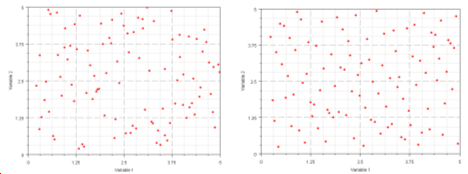Hammersley |

|

|

|

|
|
Hammersley |

|

|

|

|
Hammersley sampling belongs to the category of quasi-Monte Carlo methods. This technique uses a quasi-random number generator, based on the Hammersley points, to uniformly sample a unit hypercube.

Latin Hypercube (left) and Hammersley (right) for 100 runs.
Hammersley sampling generates the ![]() input variable values for
input variable values for ![]() designs as:
designs as:
![]()
where ![]() is the number of designs,
is the number of designs, ![]() is the number of variables,
is the number of variables, ![]() is the design index (in our case starting from 0),
is the design index (in our case starting from 0), ![]() are the first n-1 prime numbers (2,3,5,7…) and
are the first n-1 prime numbers (2,3,5,7…) and ![]() are calculated as:
are calculated as:
![]()
where ![]() are the coefficients of integer,
are the coefficients of integer, ![]() in radix-R notation which is represented as:
in radix-R notation which is represented as:
![]()
where
![]()
| • | Hammersley sampling is an efficient sampling technique that provides reliable estimates of output descriptive statistics using fewer samples than random sampling. For example, for the same number of runs, a Hammersley sample will be closer to the theoretical mean than a truly random sample. |
| • | Hammersley provides good, uniform properties on a k-dimensional hypercube. This is an advantage over Latin Hypercube sampling, which provides good uniform properties of each dimension individually. |
| • | To get a good quality fitting function, a minimum number of runs should be evaluated. (N+1)(N+2)/2 runs are needed to fit a second order polynomial, assuming that most output responses are close to a second order polynomial within the commonly used input variable ranges of -+10%. An additional number of runs equal to 10% is recommended to provide redundancy, which results in more reliable post-processing. As a result, this equation is recommend to calculate the number of runs needed or a minimum of 1.1*(N+1)(N+2)/2 runs. |
| • | Any data in the inclusion matrix is combined with the run data for post-processing. Any run matrix point which is already part of the inclusion data will not be rerun. |
In the Specifications step, you can change the following setting of Hammersley from the Settings tab.
Parameter |
Default |
Range |
Description |
Number of runs(npt) |
|
> 0 integer |
Number of new designs to be evaluated. |
Use Inclusion Matrix |
false |
true or false |
Concatenation without duplication between the inclusion and the generated run matrix. |